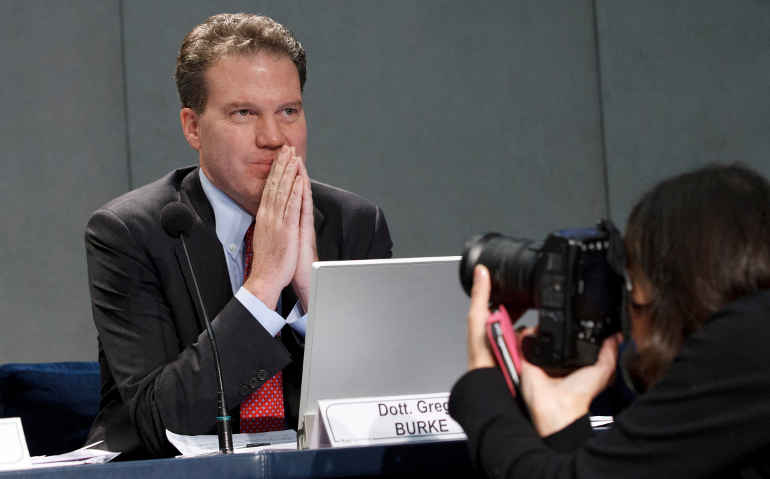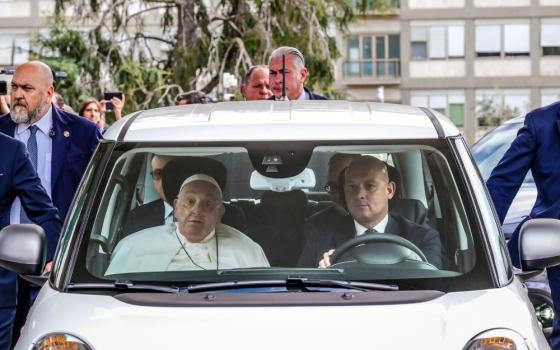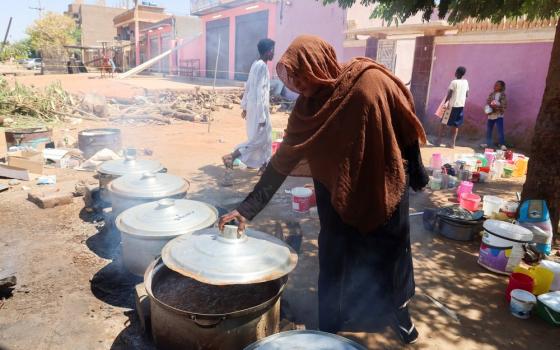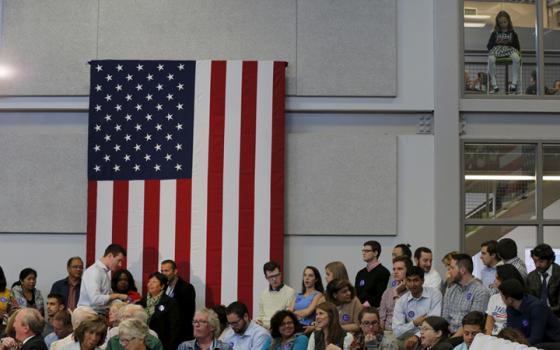
Greg Burke, media adviser to the Vatican, participates in a Dec. 3 Vatican press conference about Pope Benedict XVI's presence on Twitter, (CNS/Paul Haring)
ROME and COPENHAGEN -- Here’s a core truth about life in the church, one which often gets lost amid the clamor of whatever’s happening at the moment: The Catholic story is always a mix of shadows and light, of both heartache and hope, and emphasizing one at the expense of the other necessarily means missing part of the picture.
Events over the last couple of weeks have offered a good illustration of this “mixed bag” rule about Catholic experience.
Since late November, at least three storylines have generated controversy:
- A Nov. 19 announcement that the Vatican’s Congregation for the Doctrine of the Faith had ordered American Roy Bourgeois dismissed from both the Maryknoll order and the priesthood for his advocacy of women’s ordination.
- A Nov. 29 story that the Vatican had stripped Austrian Fr. Helmut Schüller of his title as “monsignor”, presumably because of his leadership of a priests’ movement demanding reforms in areas such as celibacy, communion for divorced and remarried couples, same-sex marriage, and women priests. (I say “presumably” because thus far, no official explanation has been offered.)
- A Dec. 1 edict from Pope Benedict XVI establishing new rules for Catholic charities, intended to beef up both financial transparency and Catholic identity. Critics see the rules as an attempt to tighten hierarchical control, and to narrow the scope of acceptably “Catholic” activity.
Some people have cheered these developments, while others lament them as abuses of power. Yet almost everyone would probably concede, perhaps especially in the cases of Bourgeois and Schüller, that it’s unfortunate things came to this point.
At the same moment these stories were unfolding, however, I had three experiences of a different sort.
First, I’ve been sounding alarms for a while about the mounting humanitarian crisis facing Syria’s Christian minority, especially Catholics concentrated in the bloodiest zones around Aleppo and Homs. On Sunday, I got this e-mail from a Polish Catholic journalist named Andrzej Kerner:
I want to inform you that your column of November 23rd inspired me to organize a bit of help for the suffering people of Aleppo. I am an editor of diocesan edtion of the Polish Catholic weekly Gosc Niedzieln (“The Sunday Visitor”). With our diocesan Caritas, we appeal for money. We will send it to a Franciscan Missionaries of Mary from Aleppo via a Polish nun born in our diocese who is now a “finance minister” for the community in the Orient (which includes Syria, Jordan, Israel, Lebanon and Egypt). ... Sorry for my very simple kind of English, but I am a regular reader of your column.
By itself, such a small gesture isn’t likely to be a game-changer. Still, it speaks to the enormous resevoir of good will among Catholics all around the world, a desire to make a difference in the lives of people at risk.
Second, I spent the latter part of the past week in Denmark, where the country’s tiny Catholic community – just 40,000 souls out of a population of almost six million – is trying to open a space for reflection about the public role of religion in one of the world’s most thoroughly secular societies.
I spoke at a well-attended panel discussion organized by the Catholic church’s Justice and Peace Commission, which featured a number of leading Danish journalists and intellectuals. To its credit, the commission organized the evening at the headquarters of a leading secular newspaper, and the line-up included a wide range of voices. For instance, a prominent Danish lawyer, a Lutheran, made the classic secular argument that church and state should be completely separate. (Speaking as an attorney, he said that any law school student in Denmark who tried to use concepts such as “justice” and “natural law” would actually flunk out.)
Early reaction seemed to indicate that the event tapped a hunger among many people, whatever their point of view, for a more vibrant conversation about religion. It also suggested that the Catholic church, despite its tiny footprint, may be the only institution that can stimulate such a debate.
Third, I was in Rome when Benedict’s new rules for charities were issued. One unforeseen consequence was that it inspired the Italian media to train a spotlight on the vast galaxy of Catholic humanitarian movements, and the astonishing work they do to translate the gospel into action among the neediest and most forgotten elements of society.
Among the figures who enjoyed a brief moment in the sun was Ernesto Olivero, the founder of the “Youth Missionary Service” movement in 1964, known by its Italian acronym “Sermig,” and the “Arsenal of Peace,” a former military installation in his native Turin that Olivero turned into a center for peace-making in 1983. Inspired by Olivero’s vision, countless young Catholics have devoted themselves to working with immigrants, alcohol and drug addicts, people suffering from AIDS, orphaned and abandoned children, and the poor.
Olivero has also played a role in conflict resolution, including helping to negotiate a peaceful end to the 2002 standoff between Israeli forces and Palestinian gunmen at the Basilica of the Nativity in Bethlehem. He’s probably one of the few people on earth who has received awards from both an Arab government, in this case Jordan, and the Israelis for his humanitarian efforts.
In 1997, Pope John Paul II gave Olivero the title of “faithful friend of all the abandoned children in the world.” He’s now 72, and it was nice to see him, and the “Arsenal of Peace”, draw some well-deserved attention.
In trying to take stock of what’s happening in Catholicism, many observers tend to focus only on the first category of developments I described above – crackdowns, controversies, and assertions of command and control. Others, often including the church’s own cadre of paid spokespersons, prefer to dwell only on the second – positive accomplishments, the church’s unique social capital, and sources of Catholic pride.
The reality, however, is that the full story always includes both. Closing one’s eyes to either is a prescription for partial blindness.
* * *
Speaking of Vatican storylines, the sexy news story this week was the announcement that Pope Benedict XVI will begin dispatching tweets on Dec. 12, under the handle “@pontifex.” There would certainly seem to be an audience for it, as the pope has already amassed over a half-million followers.
I attended a Vatican press conference announcing the initiative on Monday, where Gian Maria Vian, editor of the Vatican newspaper L’Osservatore Romano, cited Pope Paul VI’s famous line that the church should be “both ancient and modern” at the same time. In truth, you’ll rarely see the church’s past and future collide more clearly than at that Dec. 3 presser.
It isn’t just that the leader of an ancient institution is now using 21st century tools of communication to get his message out. We also caught a glimpse of the Vatican itself evolving in two ways, one cultural and the other in terms of personnel.
First, while most Vatican news conferences are conducted in Italian, this one unfolded largely in English – in part because the presentation was led by Greg Burke, the veteran American journalist recently brought on as the Vatican’s media adviser, and in part because that’s the dominant tongue of the Twitter universe.
Other players included Irish Monsignor Paul Tighe, secretary of the Pontifical Council for Social Communications, and Spanish CEO Gustavo Entrala, who presented a new iPhone and Android app to provide video streaming of papal events and other Vatican resources. (Entrala also spoke in English.)
Benedict’s first tweet will be in response to questions about the faith from people around the world. Tighe actually pulled up the first such inquiry, which came in Spanish, on his tablet while sitting on the dais in the Vatican press room.
The news conference thus offered a sense of the Vatican stepping out of its Italian shell, into a more global milieu.
Second, many Vatican watchers believe the Dec. 3 event also provided a glimpse of the future of the Vatican’s media operation, in the person of Burke. Italian writer Marco Ansaldo decreed in the pages of La Repubblica that the former Time and Fox News correspondent is “already incarnated as the future spokesperson for the Sacred Palaces.”
No doubt, Burke’s performance was a contrast with the normally restrained and formal tone of Vatican briefings. (Let me concede that Burke is a friend, so I’m hardly unbiased, but I still saw what I saw.)
For one thing, Burke didn’t subject his audience to any lofty theological or historical rhetoric before getting to the news. (Vian had already done that, tracing Benedict’s Twitter debut all the way back to Christianity’s role in the transition from stone writing tablets to the codex in the ancient world.)
Burke focused instead on the practical details, which is what most journalists came to hear. The closest he ever came to a philosophical statement was a one-liner when asked if the Vatican is worried about on-line backlash against the pope.
“It’s an open marketplace of ideas,” Burke said, “and I think that’s good.”
Burke also flashed a keen sense of humor. At one point, veteran Reuters correspondent Phil Pullella asked if the pope might use his Twitter account to push back against media coverage he doesn’t like. Pullella cited stories about the pope’s new book on the infancy stories of Jesus, which irked some in the Vatican by suggesting that Benedict had “cancelled Christmas” because he cast doubt on whether there really were oxen and donkeys at the stables, or whether angels actually sang.
The “cancelled Christmas” headline was based partly on Pullella’s own write-up, and Burke didn’t let the irony pass.
“Great job of calling attention to your own story, Phil,” he shot back, saying he’d actually love it if the pope would tweet something on the order of, “Pullella got it wrong.”
Burke added, naturally, that it’s probably not going to happen.
When a reporter from the U.K. cheekily asked if the pope’s tweets would be infallible, Burke simply burst out laughing. He turned the question over to Italian Archbishop Claudio Maria Celli, president of the Council for Social Communications – warning the reporter that he was probably in for a catechism lesson. (He proved prophetic, as Celli invoked terminology such as “ordinary magisterium” and “dogmatic declarations” to distinguish among various categories of papal utterances.)
Many believe it’s only a question of time before Burke takes over from Jesuit Fr. Federico Lombardi, spokesperson since 2006, as the public face of the Vatican. If so, it may not betoken a change in message, but it would be hard not to detect a significant shift in style.
* * *
I spent just a little over 72 hours in Denmark last week, so it would be ridiculous to try to pass myself off as some kind of expert. Still, based on what I saw and heard, I developed three hypotheses about Catholic life as a small minority up against an overwhelmingly secular culture, which I’ll pass along here.
While these observations are prompted by Denmark, they probably have some traction wherever Catholics find themselves in similar circumstances.
First, being in the same boat tends to take the edge off internal Catholic tensions. In truth, the small Danish church contains the same divisions you find pretty much everyplace – there are liberals and conservatives there too, not to mention obvious differences between ethnic Danes (actually a minority of the Catholic population) and the Poles, Vietnamese and Filipinos, each of whom have a substantial footprint.
Yet in a place where Catholics of all stripes tend to be viewed with suspicion by the mainstream culture, most Catholics I met seemed to feel a common desire to make the church more relevant and better understood. Their differences seemed less consequential than what they have in common.
On a related note, being small also means that Danish Catholics pretty much all know one another, so relationships tend to be more personal and less formal than is often the case in bigger Catholic countries.
Here’s one small but telling example. Friday night, my wife and I were invited to a dinner party at the residence of Denmark’s lone prelate, Bishop Czeslaw Kozon. Over the years I’ve attended more such social occasions than I can count, but this was the first time in my experience that the bishop actually answered his own door and played bartender throughout the evening. (I can report this: he mixes a terrific gin and tonic.)
Second, the fact that there aren’t many Catholics in Denmark doesn’t mean people aren’t interested in the church. Instead, it means that perceptions are often based on media coverage and popular stereotypes, without the benefit of any personal experience that might offer a different perspective.
Danes told me, for instance, that the European wave of sex abuse scandals in the church were big news there in 2010, even though an exhaustive analysis found precious few cases in Denmark itself. I also met a Danish journalist who had written extensively, and critically, about Pope Benedict XVI’s 2011 speech at the German Bundestag for one of the local dailies.
During my presentation, I tried to sketch what I see as three emerging social and political priorities for the global church:
- The defense of religious freedom, especially where Christians are on the firing line;
- Advocacy for the developing world, where a majority of Catholics today live;
- The attempt to rally religious moderates against radical secularism at one end of spectrum and fundamentalism at the other.
Afterwards, a thoughtful Danish Protestant told me he found the presentation fascinating but overly optimistic. Among other things, he said he doubts the Catholic church can lead a coalition of religious moderates, because “it has always claimed to be the only true Christian church, and has not allowed a dialogue on equal level with the other Christian churches.”
He conceded, however, that he doesn’t have much personal experience of Catholicism. (That doesn’t necessarily make him wrong, but even he said he worries he may not be getting the whole picture.) One challenge for Catholics in such a situation is to become a bit more visible, so people with questions or concerns about the church have someplace to talk them out.
Third, being a minority matters, but it doesn’t always matter in the same way.
Danes told me that some Catholics respond to their minority status by keeping their heads down, retreating into a sort of religious ghetto. Others feel compelled to prove that Catholicism can be acceptably “Danish,” that it’s not at odds with the mainstream ethos. Still others are driven to embrace their otherness, boldly accenting the counter-cultural dimension of Catholicism.
Simply being in the same boat, in other words, doesn’t automatically mean that everybody’s inclined to paddle in the same direction. Whether the best of these instincts can be blended into a common pastoral approach is likely to be the major drama of Catholic life here – and anywhere else that similar situations apply.
* * *
Now that Ambassador Miguel Diaz has accepted a position as Professor of Faith and Culture at the University of Dayton, President Barack Obama will have to find a new envoy to the Vatican. I spoke to a senior Vatican diplomat over the weekend who told me the pick is being closely watched in Rome as the first clear signal about what kind of relationship Obama wants to have during his second term.
Filling the slot tends to be a special headache for Democratic presidents, because they have to find somebody who can pass muster both with their party and with the Vatican. The custom that it has to be a Catholic complicates things further, because it’s not just a candidate’s policy positions that might cause problems, but his or her internal standing in the church.
For those with an appetite for speculation, names making the rounds include two members of the national “Catholics for Obama” team: Stephen Schneck of the Catholic University of America and Nicholas Cafardi of Duquesne. Both would be acceptable to the White House, but might trip some wires on the Catholic side – if not with the Vatican, which typically vetoes an appointment only if there are concerns about personal morality (especially marital status), then with the U.S. bishops.
Another hot tip is Ken Hackett, the former longtime president of Catholic Relief Services, who served on Obama’s delegation to the consistory in Rome last February when both Timothy Dolan and Edwin O’Brien became cardinals. (For all intents and purposes, Hackett was the delegation, along with Diaz).
Hackett would be an easy sell on the church side. He has a good relationship with Dolan, who served as chair of the CRS board, and he has a solid working knowledge of the Vatican from his involvement with the Rome-based federation of Catholic charities, Caritas Internationalis. How well he would play with Democrats who have to confirm the appointment is anybody’s guess.
One concern with each of these three possibilities is how much juice they would actually have with the White House and the State Department, not to mention the fact they don’t have any previous experience as official U.S. diplomats.
Further into the realm of the hypothetical, some observers have suggested that Obama could turn to one of the pro-life Democrats in Congress, such as Dan Lipinski of Illinois’ third district. Lipinski is co-chair of the Pro-Life Caucus and a co-sponsor of the “No Taxpayer Funding for Abortion Act.” He’s met with Vatican officials in the past, who have come away impressed. (Solidifying his Catholic credentials, Lipinski also taught briefly at Notre Dame from 2000 to 2001.)
The problem here is that presidents are usually loathe to take a member of their own party out of Congress. For instance, Illinois law requires a special election in which Lipinski’s seat would be up for grabs. Even though his district has chosen Democrats in 24 of the last 25 elections, it’s considered the most socially conservative in the Chicago area, and theoretically might be open to a moderate Republican.
Given the complications, perhaps it’s worth reconsidering an idea which is hardly original to me: Breaking with the traditional bias for a Catholic drawn from the American scene, turning instead to a career diplomat regardless of religious affiliation.
Three considerations support that option.
First, Vatican diplomats don’t really care whether a country’s ambassador is a Catholic. Their main concern is that the person is “serious,” meaning somebody with real standing in the government they represent who can move the ball on shared concerns.
Let’s put it this way: If Obama named somebody with the standing of the late Warren Christopher, nobody in the Vatican would squawk about him being a Methodist.
Second, since career diplomats generally steer clear of taking public positions on domestic politics, they wouldn’t carry any baggage from the culture wars.
Third, by naming a non-Catholic, a president wouldn’t have to sweat their relationship with the bishops quite as much. It would also make it less likely that somebody in the Catholic chattering classes would have a personal bone to pick with the nominee.
Granted, there are drawbacks.
First, people who’ve been around the block in U.S./Vatican relations say there are advantages to naming somebody who already “speaks Catholic.” It’s not just that the Vatican is hard to understand without background in the faith, but also because the U.S. bishops are an enormously important silent partner in the relationship. Having somebody who already knows them and their concerns is certainly useful.
Learning how to penetrate foreign languages and cultures, however, is precisely what diplomats do. Envoys who’ve been posted to Saudi Arabia or China, for instance, certainly know how to deal with a different cultural world, and they didn’t have to be Saudi or Chinese to figure it out.
As proof of the point, most Vatican observers will tell you that some of the most astute ambassadors to the Holy See over the years have been the Israelis, none of whom, naturally, have been Catholics. Similarly, the current British ambassador, Nigel Baker, is not a Catholic, but he’d make most people’s “top ten” lists for effective diplomacy in Rome.
Second, it might be dicey for Obama to be the first president to break the tradition of naming Catholics, given his already ambivalent relationship with the church. If handled badly, it could come off as another provocation or slight.
That, however, brings us back to the seriousness test. Give the Vatican a heavy-hitter, somebody whose background says the White House values this relationship, and they’ll be the first to defend the choice.
Most observers say it’ll probably be a while before Obama gets around to filling the job, partly because there are bigger fish to fry on the personnel front.
In the meantime, the U.S. Embassy to the Holy See is being led by its Deputy Chief of Mission, Mario Mesquita, a graduate of the University of California at Davis who’s previously served in the Czech Republic, Poland and Colombia, as well as within the State Department. He’s held the number two job at the Vatican embassy since August 2011, and most Roman observers say there’s been no drop-off in the embassy’s activity level since he took over day-to-day management.
[John L. Allen Jr. is NCR senior correspondent. His e-mail address is jallen@ncronline.org.]




